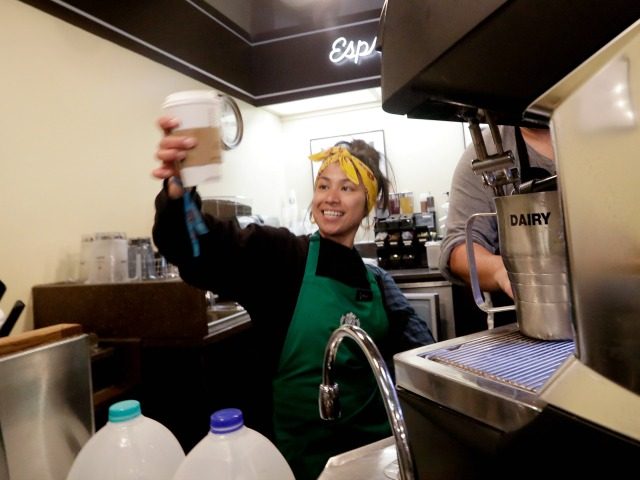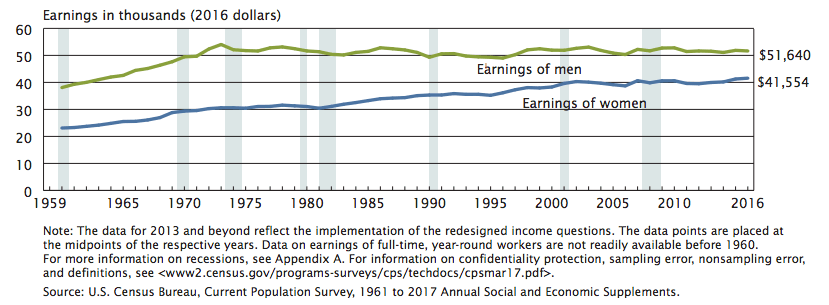Almost half of hourly-wage employers will “offer the maximum hourly wage they feel their business can afford” this summer, up from just one-third of employers in 2017, says a survey of 1,000 employers by Snag, a job-advertising firm.
Snag reported:
With record low unemployment at 3.9 percent, employers are vying to stay competitive with more employers willing to offer the maximum hourly wage they feel their business can afford (46 percent in 2018 versus 31 percent in 2017) rather than the minimum required by law (12 percent in 2018 versus 18 percent in 2017).
The pressure is also pushing three out of four employers to offer wages of $11 or more:
A result of this is that 74 percent plan to pay an hourly wage of at least $11, compared to last year when only 53 percent of employers planned to pay the same or more.
The report also noted that more employers are using the federal E-Verify system to screen illegal immigrants from jobs. The survey said that “nearly 40 percent of employers plan to use E-Verify to evaluate summer applicants, up from 25 percent last year.”
“Given the current political environment and noise around immigration and non-citizenship status, employers are clearly being more cautious,” said Snag CEO Peter Harrison.
The survey’s data suggests that millions of American voters are going to get pay raises during the summer before the election because of President Donald Trump’s lower-immigration/higher-wage policies.
The rising wages help explain the escalating demands by CEOs and investors for a federal amnesty that would provide them with another influx of wage-cutting immigrant workers. These demands have turned into threats by donors and by GOP members who are elected in low-tech dairy districts. But many polls show the public overwhelmingly prefer immigration policies which bar companies from importing cheap foreign workers until Americans can get good jobs.
The rising wages in Trump’s economy are a growing concern for Democratic planners. “It’s a very big concern,” Democratic pollster Celinda Lake, told TheHill. “The economy is the No. 1 issue out there for people, and right now Trump has a very aggressive economic message that seems to cross traditional party lines to voters.”
The summer 2018 shift by employers comes after a small but significant rise in wages during 2017.
The federal Bureau of Labor Statistics showed an after-inflation wage rise of roughly 1.8 percent during the year, marking a notable change after a decade of flat wages. “The U.S. average weekly wage increased 3.9 percent over the year, growing to $1,109 in the fourth quarter of 2017,” the BLS reported, which also showed wage shifts in various states, including Wisconsin and Indiana.
Wages continued to rise in the first few months of 2018, said a May 30 report by the Federal Reserve Bank of Cleveland:
Many firms responded to talent shortages by increasing wages as well as the generosity of their compensation packages. In the aggregate, however, wage increases remained modest in most Districts.
According to the U.S. Census Bureau, men’s wages have not risen since 1974, so just a few years of slowly rising wages would be a major improvement.
Rising optimism suggests that more Americans will start switching jobs during 2018 to extract raises from rival companies. “Sixty-seven percent of Americans believe that now is a good time to find a quality job in the U.S., the highest percentage in 17 years of Gallup polling,” Gallup reported May 21.
Amid the wage rises, Snag also reported that employers are also providing more benefits: “Snag’s survey showed employers are offering more full-time opportunities, health care and PTO benefits. This is consistent with what hourly workers want.”
The competition for workers is also prompting some employers to extend overtime hours, ensuring higher wages. “We’re thrilled to see nearly all employers are adding extra shifts this summer on top of hiring more hourly workers,” said Harrison. He added:
This is doubly good news because it likely indicates that current employees are getting more hours … Wage growth is super important but on its own [is] not enough to combat the staggering underemployment that still persists in America.
But companies are also trying control their costs by hiring more “on-demand” workers for specific tasks, said Snag. “There has also been a giant surge in interest for on-demand workers with 81 percent of employers planning to utilize on-demand workers within the next 12 months, up from 62 percent last year and 31 percent year-over-year,” it reported.
On-demand workers are provided by companies such as Uber, Lyft, Handy and Mechanical Turk, which is owned by Amazon.
Amid the wage raises, companies are working harder to fill jobs earlier. Snag reported that “more than a third (38 percent) of employers have already completed their hiring as of the end of April, compared to 27 percent in 2017.”
Company owners are more optimistic about their ability to find workers, despite complaints from many employees seeking federal approval to import foreign workers. According to Snag’s report:
95 percent of employers are adding more shifts this summer compared to last year …
Even with low unemployment, employers aren’t worried about getting enough applications this year. In fact, 60 percent anticipate getting more summer applicants than last year.
Trump’s efforts to limit legal and illegal immigration is driving up wages and salaries for Americans in various locations and careers around the country. The beneficiaries include African-American bakers in Chicago, Latino restaurant workers in Monterey, Calif., disabled people in Missouri, high schoolers, resort workers in Hilton Head, construction workers, Superbowl workers, the garment industry, and workers at small businesses, and even Warren Buffett’s railroad workers.
Four million Americans turn 18 each year and begin looking for good jobs in the free market.
The Washington-imposed economic policy of economic growth via mass-immigration shifts wealth from young people towards older people, it floods the market with foreign labor, spikes profits and Wall Street values by cutting salaries for manual and skilled labor offered by blue-collar and white-collar employees. It also drives up real estate prices, widens wealth-gaps, reduces high-tech investment, increases state and local tax burdens, hurts kids’ schools and college education, pushes Americans away from high-tech careers, and sidelines at least 5 million marginalized Americans and their families, including many who are now struggling with opioid addictions.


COMMENTS
Please let us know if you're having issues with commenting.